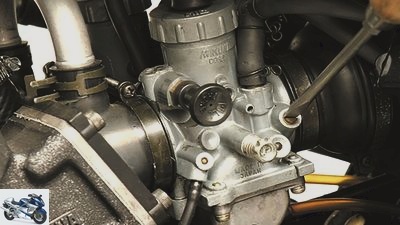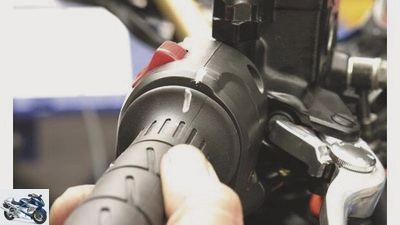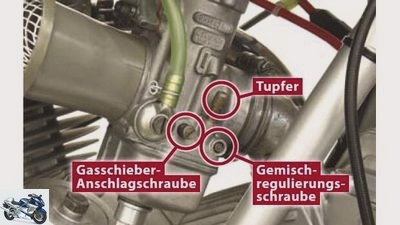Table of contents
- Adjust the carburetor This is how the correct mixture composition is achieved
- Typical problems with the carburetor
- Adjust the carburetor correctly
- Adjustment work
- More about technology
- Conclusion

Schermer
counselor
workshop
Adjusting the carburetor: the correct mixture composition
Adjust the carburetor
This is how the correct mixture composition is achieved
The engine will not run smoothly without the correct mixture composition. So what to do if it stutters or smokes? Problem analysis and adjustment tips for the carburettor on one and two cylinders.
Franz Josef Schermer
11/11/2009
At least since the introduction of the Euro 3 emissions standard, the carburettor has no longer had a chance for mixture preparation on motorcycles. Injection systems now take on this task. Since then, problems with poor throttle response have mostly been solved on the computer: a click of the mouse is enough to supply the engine management with fresh software and to correct the mixture formation accordingly. But over 90 percent of the bikes registered in Germany still have carburettors. If these twitch when opening the gas, technical know-how is required. In the following we will dedicate ourselves to the correct setting of the carburetor for one and two-cylinder engines. But first a precise problem analysis is essential.
Typical problems with the carburetor
1. Cold start difficulties: The engine starts reluctantly and keeps going off.
Possible defects: Petrol does not get into the carburetor (the cause is probably a defective petrol tap or dirty tank) Dirt in the float chamber. Idle nozzle clogged. Choke nozzle clogged. Choke control is in position “closed” and not working properly
2. Hot start difficulties: The engine only revs up with a sputter, smokes black from the exhaust pipe, and the spark plug turns on “wet”.
Possible defects: Too much gasoline in the carburettor (probably caused by a float level that is too high) “open”. Too much gasoline is being added to the air being drawn in. The mixture is too rich, the engine is drowning. Mixture control screw turned out too far or air control screw turned in too far
3. While driving: engine does not pull properly, reacts sluggishly when accelerating “swallowed” engine gets too hot.
Possible defects: The engine runs with a too lean mixture because the carburetor nozzles or the petrol inlet from the tank are dirty.Not enough fuel gets into the float chamber of the carburetor because the petrol hose from the tank is kinked (or something that is often overlooked when packing: a strap from the tank rucksack Jammed fuel hose!) Clogged tank ventilation: The ventilation hose is kinked, clogged or the ventilation hole is dirty. Another option: ventilation covered by tank bag. Carburetor setting: either the mixture control screw is screwed in too far or the air control screw is screwed out too far.

Schermer
The free travel on the throttle should be two to three millimeters. Adjust the throttle cable at the bottom of the handle accordingly.
Adjust the carburetor correctly
Idle or idle speed:
Depending on the engine configuration, the idle speed is between 900 / min (for large V2 engines), 1,200 / min (for the large four-cylinder) up to approx. 1500 / min (for the single-cylinder). The idle gas must be set so that the engine bubbles lightly and loosely when idling and does not go out when pulling the clutch and engaging first gear.
Setting the idle speed:
In the case of a single or two-cylinder engine with one throttle cable per carburettor, the idle gas is set at the stop of the throttle slide. The stop screw is generally located at the bottom of the carburetor and is usually installed horizontally to the throttle valve housing. For multi-cylinder engines with a throttle cable pulley, there is a central idle adjustment screw.
Throttle cable play (“Free travel on the throttle”):
It must be possible to move the throttle grip a certain amount without increasing the speed. Check: Apply a line of chalk to the rubber of the throttle grip and the throttle grip housing, start the engine, accelerate slightly – the speed may only increase when the two lines are two to three millimeters apart. Too much play creates sluggish, unpredictable responsiveness, too little play causes jerky driving.
Idle air regulating screw:
Their standard opening is 1 1/4 to 1 3/4 turns “open”. The further they open (“turned out”), the more air the engine gets when accelerating from idle speed. If it is turned too far (more than 1 3/4 turns), the mixture becomes lean when accelerating: you have the feeling that the engine is turning “swallowed”, does not want to accelerate properly and is on the verge of dying. If the screw is screwed in too far (less than 1 1/4 turns open), the mixture is too rich and the engine only revs up slowly.
Idle mixture regulating screw:
Their standard setting is also 1 1/4 to 1 3/4 turns “open”. In contrast to the air regulating screw, however, it regulates the flow of additional gasoline when gas is applied and more air is drawn in. If the idle mixture regulating screw is turned out too far (more than 1 3/4 turns), the engine becomes over-greased when accelerating, revs up slowly and smokes black from the exhaust pipe. On the other hand, if it is turned in too far (less than 1 1/4 turns), the engine is not getting enough fuel and will not rev up.
Nozzle needle:
It is conical in shape. When accelerating, the nozzle needle releases a larger annular gap to the nozzle assembly, corresponding to the movement of the gas slide, so that more gasoline can flow through. The nozzle needle usually has five different notches arranged one above the other, in which it is hooked into the throttle slide via a small locking ring: the standard position is usually the third notch from the bottom. If the nozzle needle is now hung a notch higher (or lower), the engine runs richer (or leaner). This allows a sensitive engine (e.g. a sophisticated two-stroke engine) to be finely tuned to different weather conditions: In dry, low-oxygen weather, the nozzle needle is hung a notch lower; a notch higher in oxygen-rich air.

workshop
Advisory: clean the carburetor
Clean the carburetor
read more

Schermer
The stop screw is generally located at the bottom of the carburetor and is usually installed horizontally to the throttle valve housing.
Adjustment work
Requirements: The engine is mechanically okay, the air filter is clean, the spark plugs are okay, the valve clearance is adjusted.
1. Let the engine warm up, ideally warm up gently for ten kilometers at medium speed.
2. Set the idle speed: In the case of a single cylinder, turn the throttle valve stop screw in or out according to the specification. For two-cylinder engines: Work the right and left carburettors alternately until you get the feeling that the engine is running smoothly and smoothly.
3. Adjust or check the throttle cable play: while the engine is running, move the handlebars all the way to the right and left as far as the steering stop. Under no circumstances should the idling speed change as a result of the steering movements.
4. For two-cylinder engines: Loosen the connections to the air filter box and pull them off the carburettors so that there is a clear view of both throttle slides. Then slowly accelerate: Both throttle slides must clear the carburetor cross-section equally. 4.1. Accelerate until the throttle slides are at the top of the edge – no step should be seen or felt: both throttle slides must clear the carburetor cross-sections. If not: correct with the adjusting screws in the top of the throttle valve cover.
5. Set response behavior from idle speed: Start the engine, turn the air control screw or mixture control screw in or out very finely until the engine is about to die. Then turn back a 1/4 turn.
6th. Subsequently step on the gas, then “Gas too” and let the idle speed drop again in a stable manner.
7th. If the engine is now fully on the gas, take a test drive: Accelerate from low speeds, the engine must pull up cleanly and must not choke
More about technology
PS knowledge: technology
- Motorcycle technology clearly explained on 97 pages (PDF)
- From starter to spark plug
- Simple teaching of physical principles
- Tips and tricks for practitioners
To the PDF for € 9.99
#image.jpg
Conclusion
The engine can only deliver its full power with properly adjusted carburettors and everything is in order on the exhaust side too. However, problems in the mixture preparation can also lead to major engine damage.
Related articles
-
Schoch 49 pictures Schoch 1/49 If the engine does not immediately idle when you let go of the throttle grip, the ability of the throttle cable to operate…
-
Carburetor functionality in the video
Smartereveryday 49 pictures Schoch 1/49 If the engine does not immediately idle when you let go of the throttle grip, the ability of the throttle cable…
-
archive counselor workshop Advisory: clean the carburetor Advice: clean the carburetor Clean the carburetor More than 90 percent of the motorcycles…
-
BMW 9 pictures Cook 1/9 Lambda probe: This component is located in the exhaust manifold and regulates the injection quantity based on the residual oxygen…
-
Restoration of the BMW R 80 G-S part 4 engine and carburetor adjustment
Cook 23 pictures Cook 1/23 Small and big changes make the almost 70 hp of the renovated R 80 G / S. Cook 2/23 The new, original air filter sits on this…
-
Restoration of the BMW R 80 G-S, part 3 structure, carburetor, electrics
Photo: Koch 10 pictures Cook 1/10 There are reasons why the R 80 G / S is back in the workshop after just a few hours. More about this in the MOTORRAD…
-
Advisory: synchronize the carburetor
Schermer 5 pictures Schermer 1/5 Step 1: Preliminary work: To adjust the carburettors, they must be freely accessible. So down with the tank… Schermer…
-
Comparison of carburetor injection
motorcycles Comparison carburetor / injection Comparison carburetor / injection (Ge) mixed calculation The days when the good old carburettors were…
-
How are carburettors synchronized
Schoch 19th pictures Schoch 1/19 A useful feature of digital synchronous clocks is the parallel representation of the suction processes (here: two curves…
-
KTM counselor technology & future Ride-by-wire system Technology: ride-by-wire system No more trains, but electronics Content of KTM is the first…